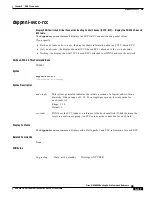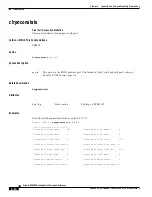
6-6
Cisco MGX 8850 Routing Switch Command Reference
Release 2.0, Part Number 78-10467-04 Rev C0, October 2001
Chapter 6
Logical Node, Port, and Signaling Commands
addaddr
addaddr
Add Address—create an ATM address.
Use addaddr to specify one or more ATM addresses for a port. The port can be a UNI or an IISP port.
For each port, the mandatory parameters are an ATM address and the length of that address. For a
description of the format of an ATM address and address planning in general, see the Cisco MGX 8850
Software Configuration Guide, Release 2 or higher.
The optional parameters for addaddr let you specify:
•
Details about the application of the address to either a public or private UNI or an IISP
•
An address plan—E.164 or NSAP
•
Whether the node at the near end of an IISP link can distribute the new address to the node at the
far end of the IISP link (making the new address visible to the nodes in other networks)
•
The scope of the ATM address
Note
Before you add an ATM address on a UNI port, disable ILMI address registration on the port. To
disable ILMI address registration, use cnfaddrreg (and supply the portID followed by “no”).
Cards on Which This Command Runs
PXM45
Syntax
addaddr <portid> <atm-address> <length>
[-type {int | ext}]
[-proto {local | static}]
[-plan {e164 | nsap}]
[-scope value]
[-redst {yes | no}]
Syntax Description
portid
The portid is the PNNI physical port. The format is [shelf.]slot[:subslot].port[:subport].
See also
PNNI Format, page 6-4
.
atm-address
The ATM address: its format depends on whether the address type is NSAP or E.164.
The address plan specifies the address type and so determines the maximum number of
bytes or bits in the address. You can specify the address plan with the forthcoming
-plan option. The default plan is NSAP.
•
An NSAP address can have 1–20, 8-bit, hexadecimal bytes. Cisco recommends that
you use 20 bytes for the NSAP address.
•
An E.164 address can 8–15 decimal digits.
The number of bits or bytes in the ATM address effects the uniqueness of the address.
The longest address ensures total uniqueness of the address. With a one-byte address,
any caller that sends an address whose first address byte matches that one-byte ATM
address goes to that port.
















































